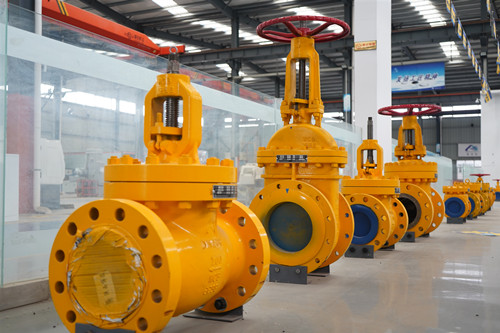Why the open and closure is difficult for large caliber globe valve?
Large diameter globe valves are mostly used for media with big pressure drop such as steam, water, etc. Engineers may face the situation, that the valve is often difficult to close tightly and prone to leakage, which is generally due to the valve body design and insufficient horizontal output torque (adults with different physical conditions have the horizontal limit output force of 60-90k). The flow direction of the globe valve is designed to be low-enter and high -exit. Manual pushes the handwheel to rotate so that the valve disc moves downward to close. At this time, the combination of three forces needs to be overcome:
1) Fa: Axial jacking force;
2) Fb: Packing and stem friction;
3) Fc: Friction force Fc between the valve stem and disc core;
The sum of the torques∑M=(Fa+Fb+Fc)R

We can draw the conclusion that the larger the diameter is, the larger the axial jacking force is and the axial jacking force is almost close to the actual pressure of the pipe network when it is closed. For example, a DN200 globe valve is used for the steam pipe of 10bar, it only closes the axial thrust Fa=10×πr²==3140kg, and the horizontal circumferential force required for closing is close to the limit of the horizontal circumferential force output by the normal human body, so it is very difficult for a person to completely close the valve under this condition. It is recommended that this type of valve be reversely installed to solve the problem of difficult closing but produce the difficult-opening at the same time. Then there is a question, how to solve it?
1) It is recommended to choose bellows sealing globe valve to avoid the impact of friction resistance of the plunger valve and packing valve.
2) The valve core and valve seat must choose the material with good erosion resistance and wear performance, such as castellan carbide;
3) Double disc structure is recommended to avoid excessive erosion due to a small opening, which will affect the service life and sealing effect.
Why the large diameter globe valve is easy leakage?
The large-diameter globe valve is generally used in boiler outlet, main cylinder, main steam pipe and other parts, which are prone to produce the following problems:
1) The pressure difference at the outlet of the boiler and the steam flow rate are both large, both have great erosion damage on the sealing surface. In addition, the inadequate combustion of the boiler makes the steam at the outlet of the boiler water content is large, easy to damage the sealing surface of the valve such as cavitation and corrosion.
2)For the globe valve near the boiler outlet and cylinder, intermittent overheating phenomenon may be in the fresh steam during the process of its saturation if the boiler water softening treatment is not too good often precipitate part of the acid and alkali substances, the sealing surface will cause corrosion and erosion; Some crystallizable substances may also adhere to the valve seal surface crystallization, resulting valve cannot be tightly sealed.
3) Due to the uneven amount of steam required by the production of valves at the inlet and outlet of the cylinder, evaporation and cavitation are easy to occur when the flow rate changes greatly, and damage to the sealing surface of the valve, such as erosion and cavitation.
4)The pipe with large diameter needs to be preheated, which can allow the steam with the small flow to be heated slowly and evenly to a certain extent before the globe valve can be fully opened, so as to avoid excessive expansion of the pipe with rapid heating and damage the connection. But the valve opening is often very small in this process, so that the erosion rate is far greater than the normal use effect, seriously reduce the service life of valve sealing surface.



Leave a Reply
Want to join the discussion?Feel free to contribute!